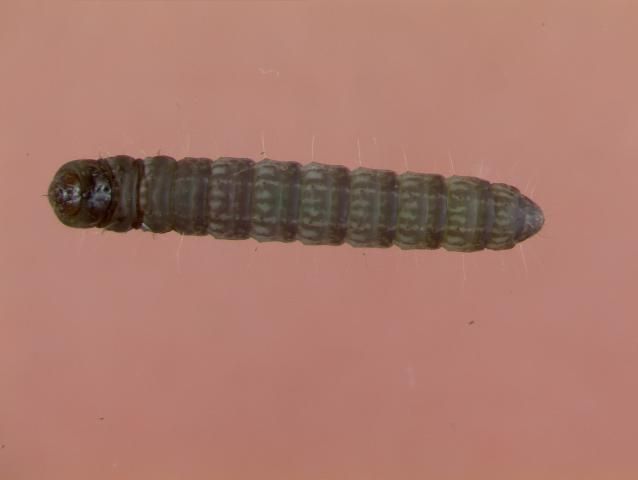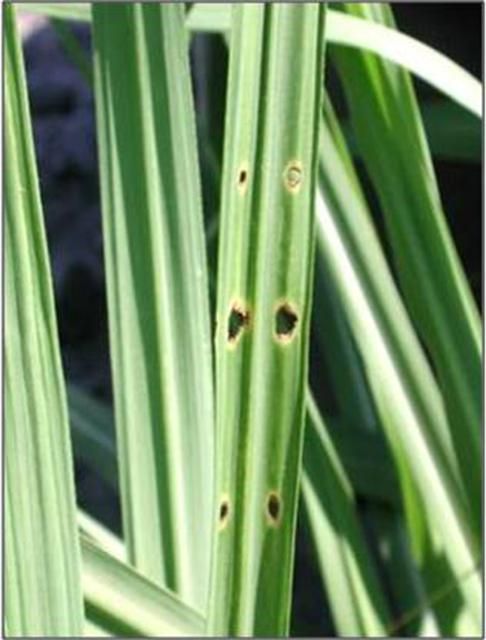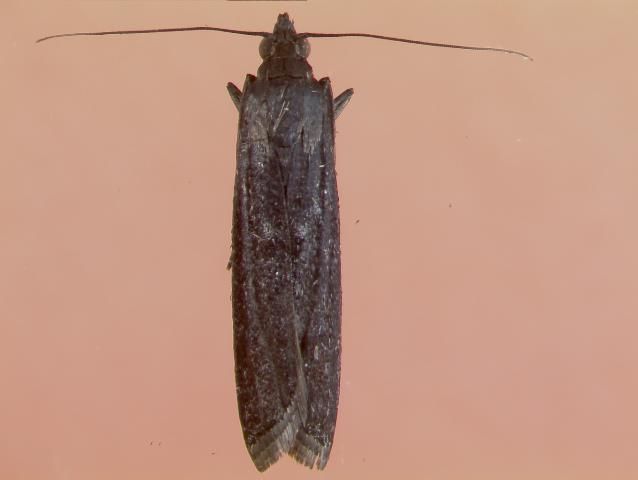Sugarcane Growth and Nomenclature
Sugarcane is grown year-round in southern Florida and harvested annually between October and late April. New fields of sugarcane are typically planted each year between September and December. Sugarcane is vegetatively propagated by planting segments of mature stalks 3–7 inches below the soil surface. Sugarcane stalks are segmented about every 6 inches by nodes, and each node has a potential growth point called a bud or "bud-eye." As the new primary shoot grows from these bud-eyes, new buds form below the soil surface at each stalk joint (node). After several weeks, these newly formed buds sprout to produce secondary shoots. New buds then develop on the secondary shoots and eventually produce tertiary shoots. These secondary and tertiary shoots are called "tillers," and the primary shoot plus all of these tillers are called the "stool." Sugarcane is harvested mechanically by cutting mature stalks (the shoots and tillers) within several inches of the soil surface.
After the "plant" sugarcane crop is harvested, it is allowed to grow back from the original stool to produce the next year's crop. These subsequent crops are called "ratoon" crops. Growers typically grow two to three annual ratoon crops after the initial plant sugarcane crop. This annual cycle of regrowth provides a habitat with year-round food sources and refuges for insects that can re-infest the sugarcane crop after each harvest. These pests can also move to surrounding crops in search of new hosts.
Lesser Cornstalk Borer (Elasmopalpus lignosellus [Zeller]) Damage to Sugarcane
Lesser cornstalk borer larvae (Figure 1) are caterpillars that feed on many grasses and broad-leaved plants, causing yield losses in crops like corn, beans, peanuts, sorghum, and sugarcane. The larvae feed on sugarcane shoots and bore into the sugarcane plant below ground level, leaving behind dead or damaged shoots. Shoots are killed when larvae feed into or below the growing point of the shoot (meristematic tissue), causing death to whorl leaves. The symptom caused by the larvae's damage is called "dead heart" (Figure 2). Dead hearts can be an indicator that the entire plant has been killed. When entire plants are killed, the reduced stalk population stands (fewer sugarcane stalks per acre) result in lower biomass tonnage and reduced sugar yield per acre at harvest.

Credit: Hardev Sandhu, UF/IFAS

Credit: Greggy Nuessly, UF/IFAS
Alternately, if the feeding occurs above the shoot growing point, the resulting damage may appear as either a temporary dead heart (which is later pushed out of the whorl by live tissue expansion below the damaged region), or as several rows of symmetrical holes in young leaves as they emerge from the whorl (Figure 3). Leaves usually break off across this row of holes within a few weeks of expansion, leading to a loss of photosynthetic surface area, reduced growth potential, and ultimately a lower sugar yield at harvest. Lesser cornstalk borer larvae pupate in the soil and develop into dark-colored adult moths with a wing expanse of 5/8 to 1 inch (Figure 4). These moths are mostly active at night, but also fly short distances (5–15 feet) when disturbed during the day.

Credit: Hardev Sandhu, UF/IFAS

Credit: Hardev Sandhu, UF/IFAS
Sugarcane Plant Response to Lesser Cornstalk Borer Damage
Sugarcane is highly susceptible to lesser cornstalk borer at critical growth stages, but can compensate for some early-season damage by producing tillers from newly forming buds. However, shoots that die in response to lesser cornstalk borer feeding may not produce new tillers.
Sugarcane's ability to compensate for early-season damage varies depending on the variety and age of plants at the time of infestation (Sandhu et al. 2011a). In greenhouse studies, similar levels of damage to some of Florida's commonly grown commercial sugarcane varieties (CP78-1628, CP88-1762, and CP89-2143) resulted in variety-specific growth and yield responses. Under controlled conditions, a lesser cornstalk borer infestation at the three-leaf stage resulted in 60%–64% dead hearts in CP78-1628 with no significant biomass yield loss, whereas an infestation in CP88-1762 resulted in 66%–68% dead hearts and a biomass yield loss of 11%–18%. Similarly, CP89-2143 infested at this early growth stage had 74%–88% dead hearts, resulting in a 25%–38% loss in biomass yield.
Averaged across all three varieties, the loss in biomass yield was 15% at the three-leaf stage, 22% at the five-leaf stage, and 38% at the seven-leaf stage, as compared to control plants (i.e., plants that had not been infested by lesser cornstalk borer larvae). In addition to biomass yield losses, sucrose yield was reduced by 15% at the three-leaf stage, 20% at the five-leaf stage, and 39% at the seven-leaf stage. When infested at the three- and five-leaf stages, CP78-1628 and CP88-1762 compensated for some damage by increasing tiller production above that of the control plants. This trend extended into the mature stalks for these two varieties with a net increase in the number of mature stalks compared to the untreated control. However, when CP89-2143 was infested at the three-leaf stage, tiller production was reduced by 18%–29% and mature stalk production declined by 28%–30% compared to the control plants. Overall, yield loss was greater for CP88-1762 than for CP78-1628 and greatest for CP89-2143. These results indicate that both the variety and age of sugarcane plants can have a significant effect on recommendations for managing lesser cornstalk borer.
Monitoring and Damage Thresholds
Based on these results, sugarcane producers are advised to manage lesser cornstalk borer from the first sign of dead hearts until the seven-leaf growth stage to prevent significant yield losses. Since yield losses increased when infestation occurred in older plants, scouting efforts should be expanded between the three- and seven-leaf stages. For varieties that compensate for early lesser cornstalk borer damage by increasing tiller production (e.g., CP78-1628), the producer could effectively wait until the first signs of infestation before initiating management practices without suffering a significant yield loss. In contrast, producers growing varieties sensitive to early damage (e.g., CP89-2143) should consider using an early warning system to forecast outbreaks and prepare for their management. For example, an early warning system could include a combination of pheromone traps to sample male moth populations near the target sugarcane fields with an assessment of degree-day models for sugarcane growth and insect population development.
These conclusions are based on experiments conducted in a greenhouse where soil, temperature, solar exposure, and lesser cornstalk borer density were controlled and their natural enemies excluded. It is not fully understood how season-long exposure to lesser cornstalk borer and insect population limiting factors (e.g., soil moisture and high summer soil surface temperatures) may affect damage and plant response throughout the sugarcane growing season.
Lesser Cornstalk Borer Control
Lesser cornstalk borer larvae are protected in the soil by their silken tunnels. These silken tunnels make it difficult to apply effective chemical and biological control measures. Many insecticides previously used for control of lesser cornstalk borer in sugarcane are no longer registered for this use (e.g., Furadan). Contact your county Cooperative Extension agent for information on insecticide products available for managing lesser cornstalk borer. The natural enemy complex of lesser cornstalk borer, including the tachinid fly (Stomatomyia floridensis Townsend), braconid wasp (Orgilus sp.), and ichneumon wasp (Pristomerus pacificus melleus Cushman), is negatively affected by pre-harvest burning to remove sugarcane leaves from the harvest stream (Falloon 1974). Although few chemical and natural controls are available that effectively control lesser cornstalk borer in sugarcane, research results indicate that harvest residues and other tillage practices could play important roles in managing lesser cornstalk borer.
Harvest Residue and Lesser Cornstalk Borer
The leafy material and tops of plants discarded in the field during harvest are referred to as sugarcane harvest residue or "trash." To reduce transport and milling costs and maximize harvesting efficiencies, most commercial sugarcane fields are burned before harvest to remove as much of this leafy material as possible. Sugarcane harvested without a pre-harvest burn is referred to as a "green cane harvest," and the leafy material left in the field is called a "trash blanket." This residue often covers the entire field to a depth of up to 12 inches. A thick trash blanket left in the field after green cane harvesting reduces lesser cornstalk borer damage in the following ratoon crop (Sandhu et al. 2011b).
A study was conducted to determine the potential use of this type of trash layer as a mulch to manage lesser cornstalk borer in plant cane. In the study, the trash blanket was manually removed from a neighboring sugarcane field (following a green cane harvest), and this trash blanket was manually spread across the freshly prepared soil (no trash) of a recently planted sugarcane field. The imported trash blanket mulch resulted in 5–8 times fewer dead hearts and 3–7 times fewer plants with holes in leaves than plots without a trash blanket. Without a trash blanket, ratoon cane suffered significantly greater damage from lesser cornstalk borer compared to ratoon cane where trash blankets were maintained. However, the damage in ratoon cane was much lower overall than in plant cane. The effect of the trash blanket on lesser cornstalk borer damage is not well understood, but trash blankets maintain higher soil moisture levels than in exposed soil. Higher soil moisture levels inhibit egg deposition by adult lesser cornstalk borer moths and increase larval mortality (Leuck 1966; Knutson 1976). There also may be greater numbers of natural enemies in fields with trash blankets than in fields with bare ground, which could promote reduced lesser cornstalk borer damage.
Tillage and Lesser Cornstalk Borer
Leaving a thick trash blanket over the field has been shown to reduce lesser cornstalk borer damage, but this practice can lead to other production challenges. Incorporating the harvest residue (trash) into the soil through tillage can reduce problems with water percolation, fertilizer application, and reduced yields in mechanically harvested green cane fields. In controlled tillage experiments, lesser cornstalk borer damage and sugarcane yield were measured in plots with no-tillage, intermediate tillage, and conventional tillage treatments in both green cane and burnt cane harvested fields. Sugarcane rows in the conventional tillage plots were cultivated very close (2.5–3 inches from row center) to the stools, which greatly reduced or eliminated the trash blanket between the rows of sugarcane. In the intermediate tillage treatment, only the center of the inter-row spaces (= 6 inches from stools) was cultivated, leaving the trash adjacent to the plant bases undisturbed. The effect of these tillage treatments on lesser cornstalk borer damage was significant in both green cane and burnt cane harvested plots. In the green cane harvested fields, those with conventional tillage had significantly more damage from lesser cornstalk borer than those with intermediate tillage or no-tillage treatments. In burnt cane harvested fields, plots with conventional tillage had less damage from lesser cornstalk borer than intermediate tillage, and plots with intermediate tillage had less damage than plots with no-tillage (Table 1).
However, lesser cornstalk borer damage was much higher in the burnt cane field with conventional tillage than in the green cane field with intermediate tillage. Maintaining the harvest residue near the plants may reduce suitable egg deposition sites near the plants (Bennett 1962), which reduces sugarcane plant damage.
In green cane harvested fields, sugarcane biomass yield (tons of cane per acre) and sugar yield (tons of sugar per acre) were greater in plots with intermediate tillage (2008 and 2009 biomass yield = 31.9 and 36.5 tons cane/acre; sugar yield = 4.0 and 5.0 tons sugar/acre) than no-tillage or conventional tillage (Table 2). However, in the burnt cane harvested fields, conventional tillage had greater yields (2008 and 2009 biomass yield = 29.1 and 34.7 tons cane/acre; sugar yield = 4.0 and 4.8 tons sugar/acre) than other tillage treatments. Differences in biomass yield and sugar yield among tillage levels are likely the result of differences in abiotic factors (soil temperature and soil moisture) and lesser cornstalk borer damage to sugarcane. Although the no-tillage and intermediate tillage plots in the green cane harvested fields had similarly low levels of lesser cornstalk borer damage (Table 1), sugar yields in no-tillage environments were typically lower than those in intermediate tillage environments (Table 2). This reduction in sugar yield in the no-tillage treatments has previously been attributed to elevated soil moisture and lower soil temperature in fields covered with trash blankets (Oliviera et al. 2001). However, the intermediate tillage treatments resulted in greatly reduced damage from lesser cornstalk borer (Table 1), while maintaining the same yield as the conventional tillage treatments.
In some cases, sugarcane plants may be able to compensate for lesser cornstalk borer damage. However, severe outbreaks of this pest can result in significant stand losses and yield reductions. Lesser cornstalk borer damage is reduced when trash blankets are left in the fields after green harvesting of sugarcane. Intermediate tillage of the trash blanket into the soil provides adequate levels of lesser cornstalk borer control while allowing for greater rain percolation and fertilizer penetration. In conventional burnt sugarcane harvested plots, conventional tillage practices resulted in the lowest lesser cornstalk borer damage and also increased biomass and sugar yields.
Average lesser cornstalk borer damage (% dead hearts) at different sampling time in fields with two harvest methods and three tillage treatments
Sugarcane yield measurements comparing effects of harvest method and tillage level in 2008 and 2009
Summary
The ability of lesser cornstalk borer larvae to cause damage to sugarcane depended on the variety and time of infestation. Equal numbers of lesser cornstalk borer larvae caused more damage in CP89-2143 than in CP78-1628 and CP88-1762. Early infestation of young plants produced more damage, but because of greater compensatory growth response (i.e., plant recovery) during the early growth period, the yield losses were lower than those recorded for late-infested plants. Older plants infested with lesser cornstalk borer did not respond with compensatory growth (did not recover well from lesser cornstalk borer damage), and thus yield losses were more pronounced when older plants suffered lesser cornstalk borer damage. CP78-1628 demonstrated the greatest ability to compensate for lesser cornstalk borer damage among the three tested varieties. Lesser cornstalk borer damage can be reduced by trash blankets resulting from green harvesting of sugarcane or through application of harvest residue to cover the soil surface around sugarcane plants. Intermediate tillage may allow greater rain percolation and fertilizer penetration while maintaining low levels of lesser cornstalk borer damage. In burnt cane harvested plots, conventional tillage had the lowest lesser cornstalk borer damage and resulted in increased biomass yield and sugar yield.
References
Bennett, F. D. 1962. "Outbreaks of Elasmopalpus lignosellus (Zeller) (Lepidoptera: Phycitidae) in Sugarcane in Barbados, Jamaica, and St. Kitts." Trop. Agric. 39: 153–156.
Falloon, T. 1974. "Parasitoids and Predators of the Lesser Cornstalk Borer, Elasmopalpus lignosellus (Zeller), on a Jamaican Sugar Estate." Master's thesis, University of Florida.
Knutson, A. E. 1976. "Damage to Corn and the Effect of Soil Moisture on Oviposition and Larval Survival of the Lesser Cornstalk Borer, Elasmopalpus lignosellus (Zeller)." Master's thesis, University of Florida.
Leuck, D. B. 1966. "Biology of the Lesser Cornstalk Borer in South Georgia." J. Econ. Entomol. 59: 797–801.
Oliviera, J. C. M., L. C. Timm, T. T. Tominaga, F. A. M. Cássaro, K. Reichardt, O. O. S. Bacchi, D. Dourado-Neto, and G. M. de S. Câmara. 2001. "Soil Temperature in a Sugar-cane Crop as a Function of the Management System." Plant and Soil. 230: 61–66.
Sandhu, H. S., G. S. Nuessly, R. H. Cherry, R. A. Gilbert, and S. E. Webb. 2011a. "Effects of Elasmopalpus lignosellus (Lepidopter: Pyralidae) Damage on Sugarcane Yield." J. Econ. Entomol. 104: 474–483.
Sandhu, H. S., G. S. Nuessly, R. H. Cherry, R. A. Gilbert, and S. E. Webb. 2011b. "Effects of Harvest Residue and Tillage on Lesser Cornstalk Borer (Lepidoptera: Pyralidae) Damage to Sugarcane." J. Econ. Entomol. 104: 155–163.